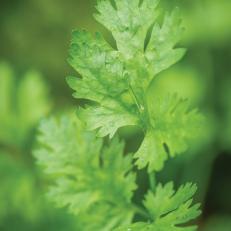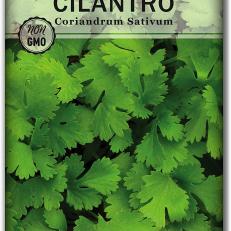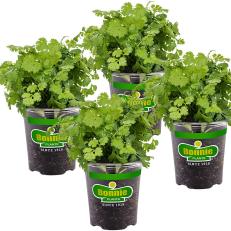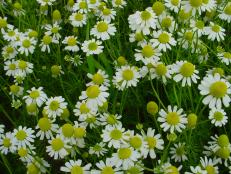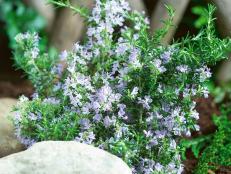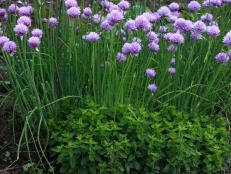How to Grow Cilantro
Growing cilantro in pots or your garden is like "two for the price of one." Harvest this herb's leaves for salsas, salads and soups and save the seeds for coriander spice.
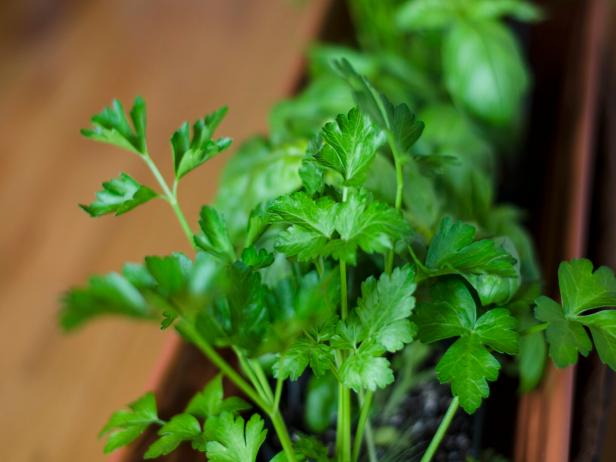
Bonnie Plants
Lacy-leaved cilantro is a pungent herb that dates back to ancient times.

Cilantro, an annual herb which is probably native to North Africa or the Middle East, has been around for centuries. Its stalks and leaves are commonly called cilantro, while its seeds are usually referred to as coriander.
Tiny white or pink cilantro flowers that open in clusters form the seeds as the plants mature. Since coriander (Coriandrum sativum) is in the parsley family (Apiaceae), you may hear it called Chinese or Mexican parsley.
But planting cilantro, which resembles flat-leafed parsley, isn't just about growing another herb. It's also a source for a spice with a lemony aroma and flavor.
Some gardeners love growing cilantro for its citrusy and slightly peppery taste. Others say cilantro has a soapy, metallic or bitter flavor. Differences in our genes may determine how we taste and smell cilantro, which explains why some people love it and others hate it.
Planting Cilantro
Growing cilantro is easy. Before you plant the seeds, rub them between your fingers to loosen their husks and then soak the seeds overnight. Sow the cilantro seeds directly in the ground after your last expected spring frost. You can plant again when the weather cools down in the fall.

Johnny's Selected Seeds
Cilantro grows quickly. Start it in fall so it's ready to harvest before the first frost.
Cilantro seeds sprout fast, so growing cilantro indoors isn't necessary. If you want to try growing cilantro indoors anyway, start the seeds in peat pots about 2 weeks before the last expected spring frost. After they sprout, in 7 to 10 days, plant the pots in the garden. Give cilantro 6 hours of full sun each day. In hot climates, the plants appreciate some afternoon shade.
Cilantro plants have long taproots, so work the soil at least 18 inches deep and remove rocks, sticks and other debris. Mix in aged compost or other rich, organic matter to add nutrients to the soil and help it drain well. A pH of 6.2 to 6.8 is ideal for growing cilantro. Rake the soil smooth and sow the cilantro seeds 1/4-inch deep, every 1 to 2 inches, in rows 12 inches apart. When they're up, thin the cilantro seedlings to every 6 to 8 inches. If you'd rather, you can buy cilantro plants from a garden center or nursery.
For best results, pinch back young cilantro plants to encourage more leaves. Remove flower buds and seed pods as soon as you see them so the plants will keep producing leaves and not put their energy into cilantro flowers.
Planting cilantro seeds every 2 to 3 weeks until the weather becomes too hot will give you a steady supply of fresh leaves and seeds.
Growing cilantro in pots is easy. Use a good quality potting mix and deep containers with drainage holes.
Growing Cilantro
When the weather heats up, cilantro starts to bolt, or produce flowers that form seeds. Once this happens, the plants quickly decline. Keep the flowering stems removed so the plants keep producing leaves. If you want more plants, let the seeds drop to the ground and sprout.
Water
Keep cilantro moist. A soaker hose or drip irrigation keeps the foliage dry so diseases are less likely to take hold. Cilantro needs about an inch of water each week.
Fertilize
Feed with a water-soluble fertilizer when your plants are two inches tall. Follow directions on your product label for how much and how often to apply.
Weed
Weed your cilantro plants and mulch them to hold down competition for water and nutrients.
Scout for Health Issues
Aphids and whiteflies are some of the few pests that infest cilantro — maybe because this herb has a strong smell. Use insecticidal soap to get rid of them. Diseases like powdery mildew and leaf spot are often caused by poor air circulation and damp conditions, so be careful not to overwater or crowd your plants.
Harvesting and Storing Cilantro
Harvesting Cilantro Leaves
Most cilantro leaves are ready to harvest in 50 to 55 days from planting. Harvest the cilantro leaves by cutting the stems near the ground, but don't remove more than a third of the leaves and stems at one time. The seeds take longer to mature.
For the best flavor, use the leaves when they're fresh. Store them in the refrigerator for a few days by putting the stems in a glass of water and covering the leaves loosely with a plastic bag.
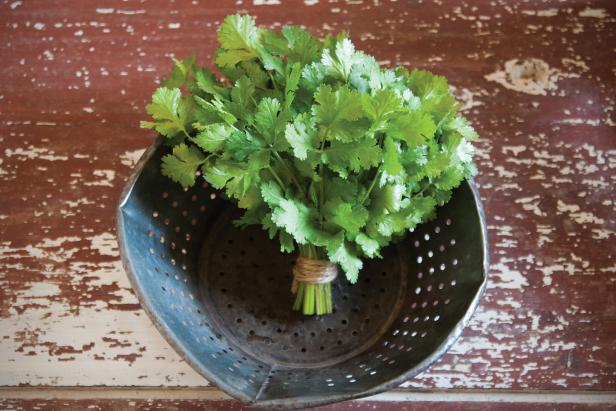
Johnny's Selected Seeds
Use fresh cilantro as a garnish, use it raw in dishes or add it to cooked foods at the last minute. It loses much of its flavor during cooking.
You can also blend cilantro and olive oil in a food processor until it's the consistency of pesto and freeze the mixture in an ice cube tray. Processed, frozen cilantro should last for several months.
To dry cilantro, wash the leaves, pat them dry, tie the stems together and hang them upside down in a dark, cool spot. Cover them loosely with a paper bag so they don't get dusty.
Havesting Cilantro Seeds
To harvest edible cilantro seeds, snip off the brown seed heads and put them in a paper bag to dry. They'll open in a few days. Store the seeds in the refrigerator or another cool, dry spot. Coriander seeds can be roasted and ground or crushed to make coriander spice.

W. Atlee Burpee
Cilantro seeds, also known as coriander, can be roasted and ground or made into a powder to use as a spice.
Cilantro Companion Plants
The best cilantro companion plants are those with the same basic needs for sunlight, water and other growing conditions. Herbs like mint, yarrow, chervil, tansy and basil are good companion plants for cilantro. Don't plant near dill or fennel to avoid cross-pollination.
Companion Planting With Cilantro
Cilantro serves as a powerful companion plant in the vegetable garden, attracting beneficial insects that prey on insect pests of a variety of crops, including tomatoes, peppers, eggplant, potatoes, beans and more.
Plants that help fix nitrogen in the soil are also good cilantro companion plants. Try peas, beans and lupines. Since cilantro repels aphids, potato beetles and other insect pests, grow it near veggies like spinach, kale, cabbage, lettuce, tomatoes, peppers and potatoes to help protect them.
Types of Cilantro
- 'Calypso' — This is a stocky, "cut-and-come-again" variety, which means you can cut the fast-growing leaves and harvest them again and again. It's said to be the slowest-bolting cilantro. The plants grow 12 to 18 inches high and wide.
- 'Santo' — Slow-to-bolt 'Santo' has a mild flavor and strong stems that grow 1 to 2 feet tall. Its seeds are ready to harvest in 95 days.
- 'Cruiser' — This vigorous variety grows more upright than 'Calypso' and is slow to bolt. Plants top out at 7 inches high and have sturdy stems.
- 'Caribe' — Grow this cilantro for its tender stems and aromatic leaves that taste slightly sweet. It's vigorous and resists bolting.
- 'Leisure' — Big-leafed 'Leisure' is extra-slow to bolt, so it's a good choice if you live in a warm climate.
Cilantro Plants and Seeds
Be aware that Vietnamese cilantro (also known as Persicaria odorata and Polygonum odoratum) is a different plant. It has a strong taste like cilantro but also has smoky notes. Native to Southeast Asia, Vietnamese cilantro can tolerate more heat in the garden but wilts fast if it's allowed to dry out. When the temperatures drop, Vietnamese cilantro can be potted up and grown indoors in bright light.







